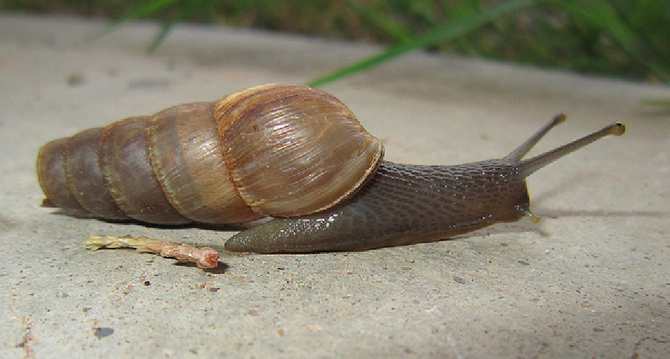 Facebook
Facebook
 X
X
 Instagram
Instagram
 TikTok
TikTok
 Youtube
Youtube

Shortly after the rainfall on the weekend of Oct. 19–21, Vista’s (southeastern) Buena Creek area and western Vista, near S. Santa Fe Avenue, were invaded by thousands of small cone-shaped snails.
The terrestrial gastropod mollusks were just about everywhere. With the moisture, they were popping out of the cracks in sidewalks, from the dirt around plants, trees, and were all over streets and driveways.
Unsure of what kind they were and where they were from, I did some research. According to Wikipedia, these little guys are decollate snails, scientific name Rumina decollata, and are ecologically beneficial for the agricultural environment. The species is native to the Mediterranean region and can grow in length to approximately 40 mm.
Intentionally introduced to America in the San Joaquin Valley and Southern California regions in the 1970s, they are regarded as Mother Nature's technique for the safest and most effective method of garden and citrus-grove pest control. They feed heavily on slugs, common garden snails, and their eggs, resulting in a reduction of approximately 50 percent of their population.
In addition, they feed on decaying plant matter (and some live garden plants and beneficial worms, unfortunately) and cultivate the soil.


Shortly after the rainfall on the weekend of Oct. 19–21, Vista’s (southeastern) Buena Creek area and western Vista, near S. Santa Fe Avenue, were invaded by thousands of small cone-shaped snails.
The terrestrial gastropod mollusks were just about everywhere. With the moisture, they were popping out of the cracks in sidewalks, from the dirt around plants, trees, and were all over streets and driveways.
Unsure of what kind they were and where they were from, I did some research. According to Wikipedia, these little guys are decollate snails, scientific name Rumina decollata, and are ecologically beneficial for the agricultural environment. The species is native to the Mediterranean region and can grow in length to approximately 40 mm.
Intentionally introduced to America in the San Joaquin Valley and Southern California regions in the 1970s, they are regarded as Mother Nature's technique for the safest and most effective method of garden and citrus-grove pest control. They feed heavily on slugs, common garden snails, and their eggs, resulting in a reduction of approximately 50 percent of their population.
In addition, they feed on decaying plant matter (and some live garden plants and beneficial worms, unfortunately) and cultivate the soil.
Comments